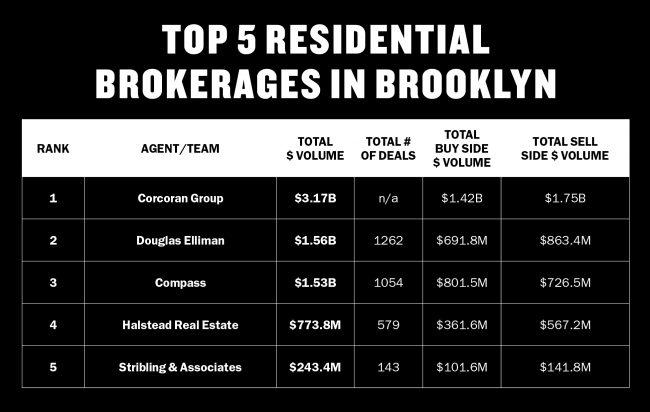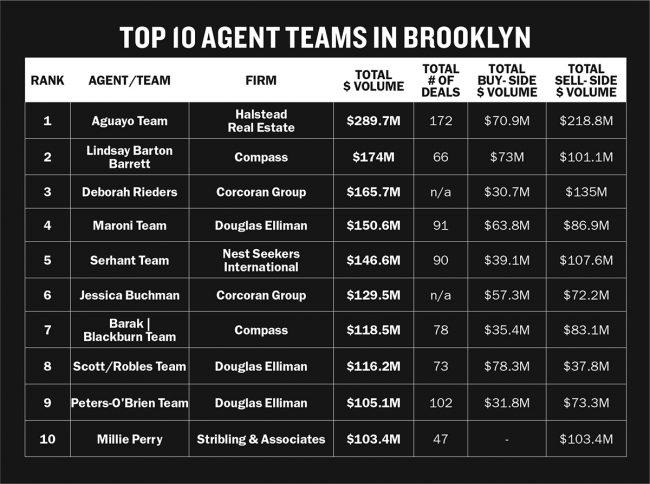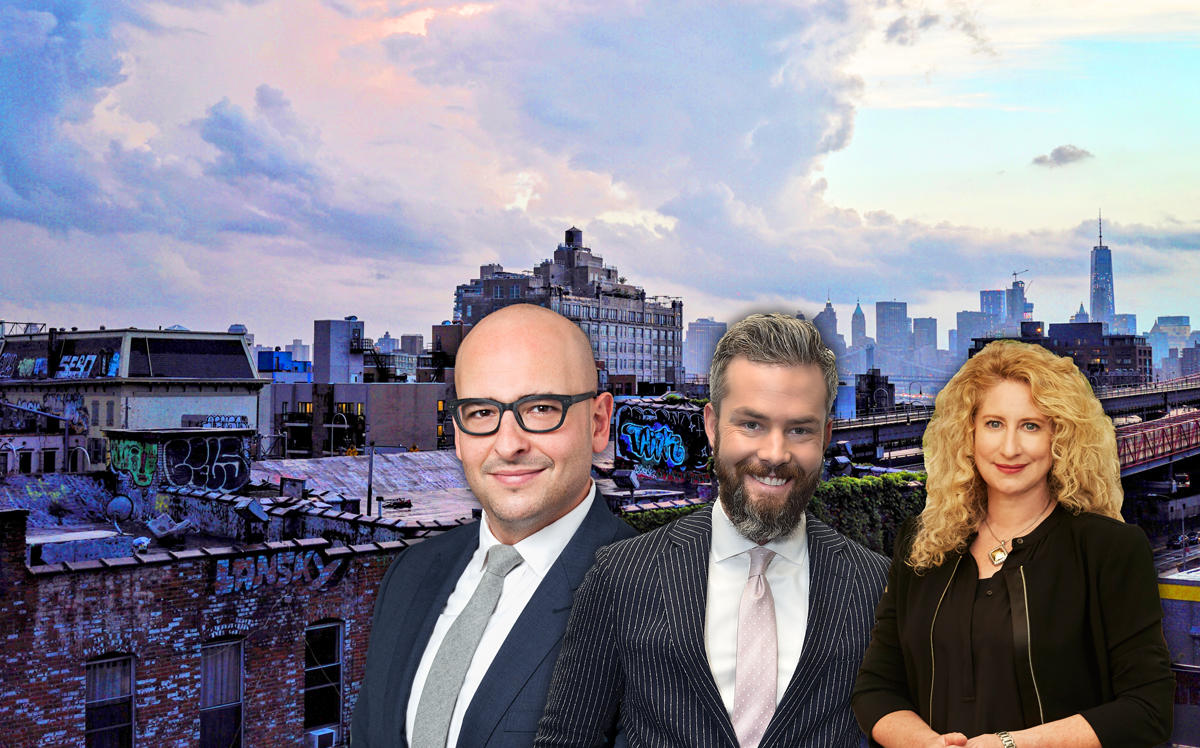Three years ago, Ryan Serhant had no presence in Brooklyn. Last year, his Nest Seekers International team did about $147 million worth of deals in the borough.
“I needed to diversify a few years ago from the slowing Manhattan market, and I needed to make sure that we were doing transactions at all dollar amounts for my entire team,” he said, “so we now have projects from South Brooklyn to Bed-Stuy.”
Serhant’s team at Nest Seekers placed fifth on The Real Deal’s recent ranking of Brooklyn’s top agent teams. Although it is difficult to arrive at definitive numbers for the 2017 sales volume of Brooklyn brokerages, TRD obtained its figures by crosschecking sales data from an analysis of StreetEasy’s online records, with sales figures for both buy and sell-side transactions provided by the firms themselves, which TRD vetted. However, some major firms, such as Brown Harris Stevens, elected not to participate and were thus not included by default.
For overall firms, Corcoran Group was on top by a wide margin with approximately $3.2 billion worth of sales in Brooklyn. Douglas Elliman came in second with about $1.6 billion worth of sales, and Compass was next with about $1.5 billion.
Halstead Real Estate came in fourth with roughly $774 million, followed by Stribling & Associates at roughly $243 million.
Corcoran had a fairly even split between the buy side and the sell side, with about $1.4 billion on the buy side and $1.7 billion on the sell side, as did Douglas Elliman, with about $692 million on the buy side and $863 million on the sell side. Compass also had an even split of roughly $801 million on the buy side and $726 million on the sell side.
Halstead was more concentrated on the sell side — roughly $567 million to $362 million — while Stribling also had a fairly even split — roughly $102 million on the buy side compared to roughly $142 million on the sell side.

Source: The Real Deal analysis of Brooklyn listings and sales on StreetEasy and from firms and public property records. Includes residential sales recorded as closed in 2017 in ACRIS. Brokerage credit was given to the teams/agents that listed the property for the seller and buyer. For deals with more than one listing agent/team at the same firm, the dollar value of the deal was divided by the number of agents/teams on that deal at that firm. (For example, a $10M sale with three teams from the same firm would yield $3.33M for each team at that firm.) But if a sale was co-brokered with an agent/team at another firm, each agent/team was given the full dollar value of the sale. Only residential sales of apartments and townhouses with no commercial/retail component were included. Townhouses include single-family houses or properties marketed as such. On-site agents who work exclusively for a developer were not counted. However, agents who work for brokerages were given credit for their new development listings. Deals that could not be confirmed on a public database were accepted if proper documentation was provided. Not all firms and agents participated.
(TRD ranked Manhattan’s top residential firms by closed sales for 2017 earlier this year, and Corcoran was number one in that borough as well with $6.29 billion in deals. However, it is generally easier to obtain definitive numbers for Manhattan than Brooklyn based on the amount of Manhattan listings in On-Line Residential that can be cross-checked with closed sales in public records.)
Gina Castellano, Brooklyn sales manager for Stribling, said buyers in Brooklyn are far more flexible about the neighborhood and type of housing than they were in the past. With all the new condo product, it’s no longer just the townhouse market wooing buyers.
“You now have the option of living horizontally as opposed to vertically in a house,” she said. “And you have all those amenities, and you’re not shoveling snow.”
Max Dobens, who heads up Brooklyn sales for Douglas Elliman, said that the borough still has room to grow, largely because its prices are lower than in Manhattan.
“You can go to Bed-Stuy and buy a whole brownstone for $2 million,” he said. “I used to run the West Village office, and the last time you could buy something in the West Village for $2 million I wasn’t born.”
The top agent teams in Brooklyn largely hailed from the biggest firms, with teams from Halstead, Compass, Corcoran, Stribling and Douglas Elliman making the board.

Source: The Real Deal analysis of Brooklyn listings and sales on StreetEasy and from firms and public property records. Includes residential sales recorded as closed in 2017 in ACRIS. Brokerage credit was given to the teams/agents that listed the property for the seller and buyer. For deals with more than one listing agent/team at the same firm, the dollar value of the deal was divided by the number of agents/teams on that deal at that firm. (For example, a $10M sale with three teams from the same firm would yield $3.33M for each team at that firm.) But if a sale was co-brokered with an agent/team at another firm, each agent/team was given the full dollar value of the sale. Only residential sales of apartments and townhouses with no commercial/retail component were included. Townhouses include single-family houses or properties marketed as such. On-site agents who work exclusively for a developer were not counted. However, agents who work for brokerages were given credit for their new development listings. Deals that could not be confirmed on a public database were accepted if proper documentation was provided. Not all firms and agents participated.
Brendan Aguayo’s team at Halstead topped the list in Brooklyn, with about $290 million in volume during 2017. Lindsay Barton Barrett at Compass came next with about $174 million, followed by Deborah Rieders of Corcoran with about $166 million.
Alexander Maroni’s Douglas Elliman team was next with roughly $151 million, while Serhant’s team at Nest Seekers International rounded out the top five with about $147 million. His was the only team whose parent company was not among the top five overall firms.
Aguayo said his team generates much of its business along the borough’s Fourth Avenue corridor, although he sees most of the growth now concentrated in neighborhoods east of Prospect Park like Crown Heights, Prospect-Lefferts Gardens and Windsor Terrace.
He described the “renaissance” in Brooklyn as having started about 20 years ago, and while he predicted that secondary markets in the borough would continue to transition into primary markets, he did see its pace of growth slowing down eventually.
“I don’t know if there’s a plateau. I’d like to say no,” he said. “I don’t know if it will be compounded as much as you’ve seen the past couple of years this coming cycle, but I still think there’s room to grow.”
The two factors people looking in Brooklyn generally focus on are either architecture or convenience to Manhattan, according to Rieders. People who want brownstones generally start in Park Slope and then move outward into Windsor Terrace or Kensington, while people who want convenience focus on neighborhoods like Williamsburg and Dumbo.
These are generally two very distinct groups, but there is overlap occasionally.
“Sometimes you can get both,” she said. “I think Williamsburg, while it didn’t have the most beautiful architecture necessarily, it certainly does offer some very interesting architectural possibilities.”
Maroni argued that convenience to Manhattan is becoming less of a dominant factor as Brooklyn becomes more of its own self-sufficient destination, with an increasing number of places for people to work, live and play.
“People come to the borough and stay at the Wyatt Hotel in Williamsburg and have season tickets for something at Barclays Center,” he said. “That’s a very different thing from what Brooklyn had 10 years ago.”
